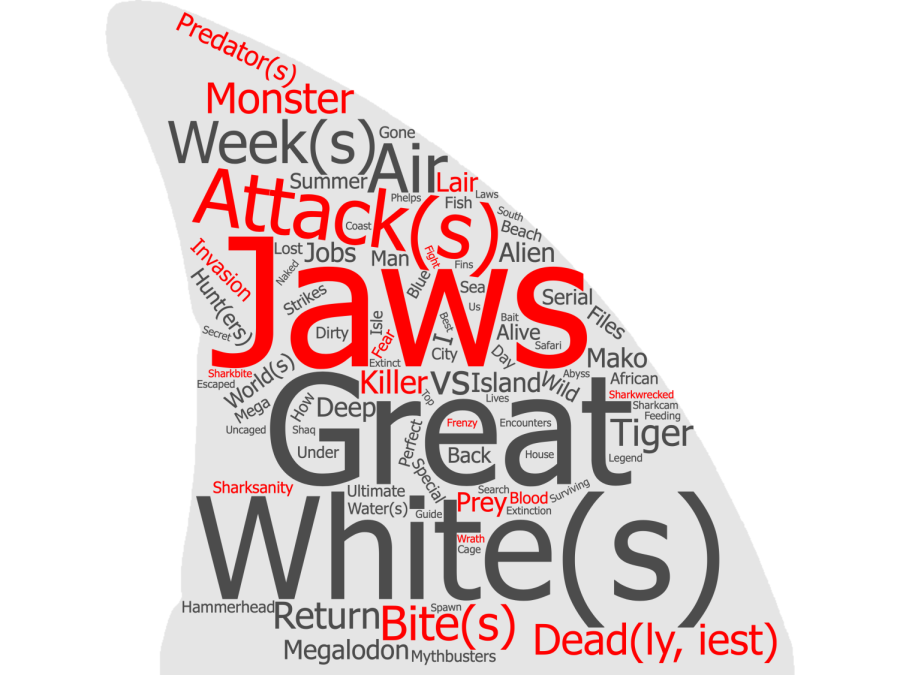Taking on Shark Week: Film, fins and fiction
The most common words from the titles of Shark Week episodes from 1988-2020. Red words have a negative connotation.
Think of where you’ve seen sharks in pop culture.
Many of you probably thought about something like Bruce, the great white in both “Jaws” and “Finding Nemo.” Maybe you thought of the “Baby Shark” song or one of my favorite terrible movies, “Sharknado.”
Many folks probably ended up thinking about Discovery Channel’s “Shark Week.” This week-long programming bonanza is hugely popular, pulling in 21 million viewers in 2020. “Shaq Does Shark Week” brought in 3 million viewers alone — the same as the final game of the 2021 Stanley Cup.
For most people, Shark Week is where they get their information about sharks, what shark science is like, and who shark scientists are. For your average shark scientist — like me — it’s a love-hate relationship. I love that people are interested and want to learn! But there are so many frustrating things. Scientists like me have been vocal critics of the focus on shark “attacks” and great whites, the over-reliance on white males as experts, and straight-up lying and misinformation in these programs. Combating the misinformation in “Megalodon: The Monster Shark Lives” is how I ended up on Shark Week myself. If Shark Week is the only place they get their information, it’s no wonder that people don’t know that 33% of sharks and their relatives are threatened with extinction, mostly due to overfishing. It’s no wonder people think they’re mindless killers — they’re not — or that Megalodon is still out there — it’s been extinct for over 3 million years.
In my FS101 “Sharks and Recreation,” we explore Shark Week, and it was those conversations that led us to do a content and discourse analysis on 32 years of Shark Week programming. Brady Mickley, ’22, colleagues and myself watched 201 episodes of Shark Week to document everything we could about the sharks, the science, the experts and messaging. It ended up being a perfect pandemic project.
We found more good things than we were expecting, but it was often paired with frustrating things. We expected a lot of fear-mongering messaging, and that occurred in 74% of episodes. However, good messaging — that sharks are misunderstood, graceful — occurred in 63%. Episodes usually had both in one episode, with a lot of bad and then a good message at the end. Many studies show that this is not an effective way to get the good points across. This has consequences. People are less inclined to help with conservation efforts if they think the animal is bad. Conservation-based messaging occurred in 53% of episodes, but rarely contained any information about how viewers could take action.
We found that there have been 79 species of sharks and their relatives featured, which was much higher than we expected. However, the top five species featured definitely don’t match the top five sharks that scientists study. Interestingly, the sharks most featured — great whites, tigers and bulls — were not the ones most threatened with extinction. We saw that 53% of episodes were natural history or research-based, while 15% were about shark attacks. The research that was shown was mostly field-based techniques that look good on TV — being in the water with sharks, tagging them and using cameras. Again, this contrasts with what shark scientists do for a living. Some people do that stuff, but many do not.
The part that hit hardest for me was when we looked at the featured experts. We looked up their pronouns when we could, assessed race and looked into their credentials. 94% of experts were white. 30% were associated with she/her pronouns and none with non-binary pronouns. 23% have not published scientific papers, but are often portrayed as scientists. Of the hosts and experts featured in more than five episodes, there were more men who were non-scientists named “Mike” than there were women of any name or occupation.
To someone watching Shark Week and dreaming of becoming a marine biologist, the message they get is that you have to be an able-bodied white male that does field work to be a successful shark scientist. None of that is actually true. 56% of American Elasmobranch Society members use she/her. Minorities in Shark Science has over 300 members. Personally, I have some chronic health issues that make it hard to be in the field; luckily I love museum and lab work just as much. Lots of others who study sharks or marine biology in general never work outside the lab. Representation matters, whether it’s the representation of the work we do in this field or of the people doing it.









